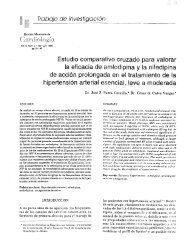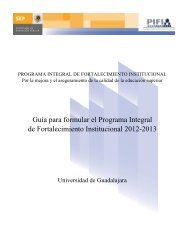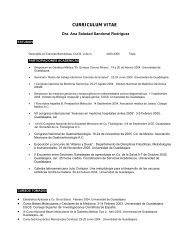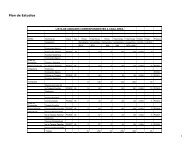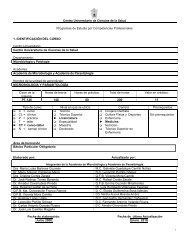Desigualdad Social y Equidad en Salud: Perspectivas Internacionales
Desigualdad Social y Equidad en Salud: Perspectivas Internacionales
Desigualdad Social y Equidad en Salud: Perspectivas Internacionales
- No tags were found...
You also want an ePaper? Increase the reach of your titles
YUMPU automatically turns print PDFs into web optimized ePapers that Google loves.
a direct or indirect impact on health equity; and some studies that reported pilot ordemonstration projects.The databases included PUBMED, Scielops and journal Health policy, includingarticles from 1995 to April of 2005. The keywords included were: Delivery of HealthCare, Health Care Reform, Health Services Accessibility, Latin America, CaribbeanRegion, Health Care Sector and National Health Programs. Some other docum<strong>en</strong>tsconsidered relevant to understand the background of the process of reforms are alsorefer<strong>en</strong>ced. Only the most relevant docum<strong>en</strong>ts are refer<strong>en</strong>ced.Background of the Processof Dec<strong>en</strong>tralizationHealth Sector reform has be<strong>en</strong> a, if not the key policy in Latin America and the Caribbeanregion (LAC) for the past two decades with a number of common ingredi<strong>en</strong>ts(World Bank 1993). These include increased limitations on the role of the publicsector coupled with new inc<strong>en</strong>tives for the private sector and new forms of publicprivaterelations, dec<strong>en</strong>tralization, integration of vertical programmes into mainstreamdelivery, hospital semi-autonomy, greater diversity in the financing of healthcare, new processes of priority setting and resources allocation, new inc<strong>en</strong>tives forhealth workers, and consumer ori<strong>en</strong>tation to service provision and community participation.(Gre<strong>en</strong> and Collins 2003)During the 1970’s and 1980’s, political leaders, users, providers, and researcherswere all aware that the health care systems in Latin America had accumulated sucha large number of ineffici<strong>en</strong>cies and inequities that something needed to be done toreverse and revert the increasing users’ dissatisfaction, decreasing quality of care,and the need to improve equity and effici<strong>en</strong>cy to the systems. (Homedes and Ugalde2005)The International Monetary Fund (IMF) and the World Bank took advantageof the crisis of the 1980’s to press Latin American governm<strong>en</strong>ts to introduce healthreform as a condition for borrowing (CEPAL 1994). This introduction could haveresponded more to ideological concerns and the interest on international grantingag<strong>en</strong>cies and did not include the epidemiological profile, the curr<strong>en</strong>t health systemor the resources and socio-political reality of the country. The World Bank Report of1993, which was used by many countries as the main docum<strong>en</strong>t for reform reflectedan international ideological shift to neo-liberal or new right t<strong>en</strong>d<strong>en</strong>cy. It is widelyaccepted that the reforms were rarely based on evid<strong>en</strong>ce, were top-down and wereoft<strong>en</strong> externally imposed. (Gre<strong>en</strong> and Collins 2003)Aiming to achieve equity in health through dec<strong>en</strong>tralization has be<strong>en</strong> one of themain drivers of the health reform in Latin America. The reforms on the health caresystem in Latin America have promoted dec<strong>en</strong>tralization as a means of achieving10 Dec<strong>en</strong>tralization And Equity



